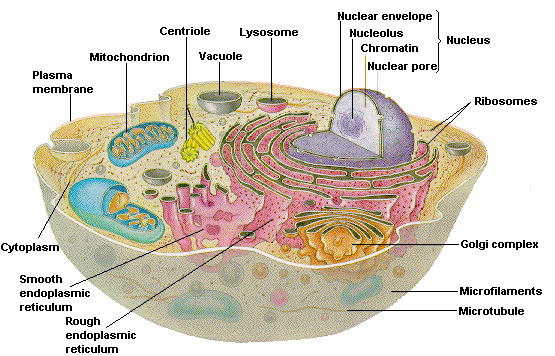The cell is the fundamental unit of life. It is estimated that the human body has 10 trillion (10,000,000,000,000,000,000) cells; each one is independently alive but combine to make a single person.
Cell (Plasma) Membrane
This forms the outer boundary of the cell and holds it together. The membrane is very similar to a soap bubble; it is flexible and can even repair itself. Many substances can’t pass through the membrane, but proteins embedded within it act like tunnels for specific things such as nutrients to pass between the fluid inside the cell and the fluid outside. Sometimes cells release chemicals that allow them to communicate with others; these chemicals fit into receptors that cells place in their membrane, a bit like keys fit into locks, and cause a change in cell behaviour.
Organelles
The body needs organs like the heart or liver to perform certain functions; cells need little organs too, to perform functions such as making energy, and these little organs are called organelles.

Cytoplasm (Cytosol)
The cytoplasm is a jelly inside cells; because it is colourless you can’t see it, but it’s important because it holds the organelles of the cell in place.
Nucleus
The nucleus is an organelle that contains long string-like structures called chromosomes; these strings are made up of a chemical called DNA, which creates the language living things use to store the instructions required to develop, grow and survive.
Blocks of DNA that contain a particular set of instructions are called genes. It might be useful to think of the nucleus as a library; each book is a chromosome and each chapter a gene. Combining letters of the alphabet produces the words making up the text and DNA is the cell’s alphabet. Sometimes, spelling mistakes are made and this can result in diseases like Batten’s.
Ribosome
Ribosomes are organelles that make proteins. Proteins can be thought of like different coloured beads on a string. Each bead is put in a certain position on the string according to the instructions in the genes. Ribosomes translate these instructions into the proteins that the body needs to work properly.
Rough Endoplasmic Reticulum
This is a network of membrane similar to the cell membrane, but inside the cell. Studded on the membrane are ribosomes, so it is here that proteins are assembled.
Smooth Endoplasmic Reticulum
This is a tube-like membrane in which fats are made. Fats are important components of membranes and are also used for making substances such as some hormones. The endoplasmic reticulum is also where processes such as drug detoxification are carried out.
Golgi Apparatus
The Golgi apparatus is a stack of membranes named after the scientist who discovered them. When substances have been made in the endoplasmic reticulum they are transported to the Golgi apparatus. Here they are packaged appropriately and given a label that allows them to be delivered to the appropriate location in the cell. For example, enzymes that need to go to the lysosome get the appropriate address label in the Golgi apparatus; if this labelling process goes wrong it causes the lysosomal storage disorder I-cell disease.
Mitochondria
Mitochondria are the power plants of the cell and even carry their own genetic information. This energy is used to make new cell components or fuel processes like muscle contraction.
Lysosomes
Lysosomes are fluid filled bags that contain a variety of enzymes, which break down potentially harmful materials in the cell. They provide a safe place to store these enzymes without damaging the rest of the cell. Sometimes, when an organelle is worn out, it starts to malfunction and so the cell needs to remove it by digesting it in a lysosome; this is a process called autophagy (self-eating). Although lysosomes are often thought of as waste-bins they are more like recycling plants, that dispose of waste and reuse other components.
Kim Wager, PhD
